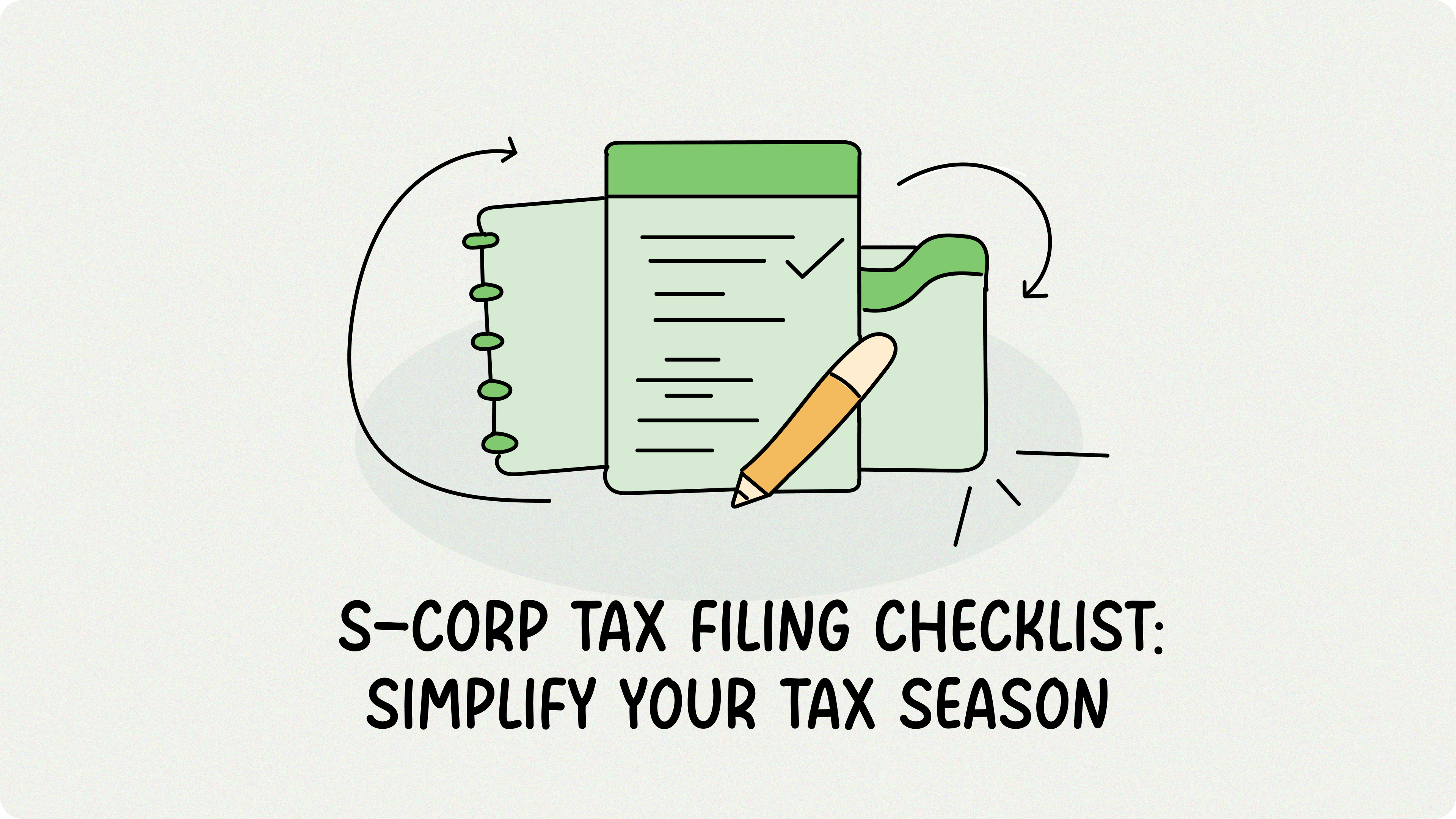Tax season for a small business owner is a bit like a marathon—you know the finish line is coming, but getting there requires preparation, stamina, and a good plan. For S-Corporations, the process has its own unique rules and deadlines. Missing a step or a key date can lead to a lot of headaches (and penalties!).
This checklist is designed to help freelancers and small business owners in the USA navigate their S-Corp tax filing with confidence. We’ll break down the forms you need, the documents you must gather, and the critical deadlines to keep you on the right side of the IRS.
Table of Contents
- S-Corp Taxation Explained
- The Most Important Deadline to Know
- The S-Corp Tax Filing Checklist
- The Cost of Missing a Deadline
- Get Ready for a Smoother Tax Season
S-Corp Taxation Explained
First, a quick refresher. S-Corps are known as “pass-through” entities. This means the business itself typically doesn’t pay federal income tax. Instead, the profits, losses, deductions, and credits “pass through” to the shareholders (that’s you!) who then report them on their own personal tax returns. This is a huge benefit because it avoids the “double taxation” that C-Corporations face.
However, just because the business doesn’t pay income tax doesn’t mean it gets a free pass. You still need to file an informational return with the IRS, which is where this checklist comes in.
The Most Important Deadline to Know
For a calendar-year S-Corp, the main deadline for filing your federal return is March 17, 2025 (for the 2024 tax year), because March 15, 2025 falls on a Saturday and the due date moves to the next business day. For the 2025 tax year, the deadline will be March 16, 2026 (since March 15, 2026 falls on a Sunday). Mark your calendar and don’t miss it!
If you need more time, you can file for an extension using Form 7004, which will give you an additional six months to file. But remember, this only extends the time to file, not the time to pay. If you expect to owe any tax (for things like built-in gains or excess passive income), you must pay it by the filing deadline (March 17, 2025; March 16, 2026) to avoid penalties and interest.
The S-Corp Tax Filing Checklist
Let’s get down to business. Here are the items you’ll need to prepare for your S-Corp tax filing.
1. Essential Financial Records
Start by getting your financial house in order. Make sure invoices and receipts are organized and complete.
- Finalized Profit & Loss Statement (P&L): This report is crucial as it provides the key numbers for Form 1120-S, particularly Gross Receipts or Sales, Cost of Goods Sold, and Gross Profit. It summarizes your company’s revenues, costs, and expenses over the last tax year.
- Finalized Balance Sheet: This provides a snapshot of your company’s assets, liabilities, and owner’s equity at the end of the tax year. The IRS requires this on Schedule L of Form 1120-S if your business has total assets of $250,000 or more or total receipts of $250,000 or more.
- Payroll Records: Documentation of all salaries paid to officers and employees, including yourself. This does not include payments to freelancers or outside contractors; those are reported separately on Form 1099-NEC if the payment exceeds $600. If the payment is less than $600, you are not required to file a 1099-NEC.
- Depreciation Schedules: If you bought any significant assets (like new equipment or vehicles) for your business, you’ll need a schedule detailing their depreciation. This helps you fill out Form 4562, Depreciation and Amortization. To get this schedule, you need to know the asset’s cost, the date it was placed in service, and its “useful life.” The most common method, straight-line depreciation, simply divides the asset’s cost (minus its salvage value) by its useful life to get the annual deduction.
- Mileage Logs: A detailed, contemporaneous record of business-related vehicle use (date, destination, business purpose, miles). These logs substantiate and calculate the vehicle expense deduction—claimed on Form 1120-S (and on Form 4562 if the S-corp owns the vehicle) or, for personal vehicles, via accountable-plan mileage reimbursements deducted by the S-corp.
- Records of Capital Contributions & Distributions: Any money you’ve put into or taken out of the business should be well-documented. This information is critical for filling out Schedule K-1, as it impacts the basis for each shareholder and determines how much of the profit or loss “passes through” to their personal return.
2. Key IRS Forms
As a business owner, you become an expert in many things—and tax forms are no exception. Here’s a breakdown of the most important forms you’ll encounter and a heads-up on what to watch out for.
- Form 1120-S: U.S. Income Tax Return for an S Corporation
This is the big one—the main informational return for your business. It reports the income, gains, losses, deductions, and credits for the year. This form is often the most complicated for first-time filers. A common mistake is forgetting to attach all the necessary supporting schedules, so be sure to double-check that everything is included before you file.
- Schedule K-1 (Form 1120-S): Shareholder’s Share of Income, Deductions, Credits, etc.
You’ll need to prepare a Schedule K-1 for each shareholder, detailing their specific share of the S-Corp’s profits and losses. You must also provide a copy to each shareholder (including yourself!) to use for their personal tax returns. A frequent error here is miscalculating each shareholder’s ownership percentage, which can lead to incorrect profit/loss allocations.
- Form W-2: Wage and Tax Statement
As a shareholder who also works for the S-Corp, you must pay yourself a “reasonable salary.” You’ll need to issue yourself a W-2 for this income, which is subject to FICA taxes (Social Security and Medicare).
- Form 940 & Form 941
If you have employees (including yourself), you’ll need to file these payroll tax forms. Form 941 is the Employer’s Quarterly Federal Tax Return, while Form 940 is the Employer’s Annual Federal Unemployment (FUTA) Tax Return.
- Form 4562: Depreciation and Amortization
This form is essential if your business purchased or started using assets during the tax year, like a vehicle or new office equipment. You’ll need to use it to claim a deduction for the gradual wear and tear of those assets over time. Many S-Corps miss out on valuable deductions by either failing to file this form or making a simple mistake.
One of the most common errors is incorrectly classifying your assets, which determines how quickly you can write them off. For example, computers and vehicles are generally 5-year property, while office furniture is 7-year property. Another big mistake is not taking advantage of a Section 179 deduction or bonus depreciation when you’re eligible, which can let you deduct a large portion of an asset’s cost in the first year.
- Form 1099-NEC: Nonemployee Compensation
This form is for reporting payments to freelancers or independent contractors who are not employees. You must file a 1099-NEC for each person you paid $600 or more during the year.
The most common mistake with this form is missing the filing deadline, which is January 31st. The penalties for a late filing can be as high as $330 per form. Another frequent error is using the wrong form (e.g., using a 1099-MISC instead of a 1099-NEC for non-employee compensation) or entering an incorrect Taxpayer Identification Number (TIN), so be sure to double-check that information!
3. Don’t Forget These Details!
A few small mistakes can lead to big problems. Double-check these items before filing.
- Shareholder Information: Make sure you have the correct names, addresses, and Social Security Numbers (or other Taxpayer ID numbers) for all shareholders.
- Reasonable Salary: The IRS has a keen eye on S-Corp owners. The issue isn’t just paying yourself too little to avoid FICA taxes; it’s also a problem if you pay yourself too much, as this can limit the amount of profits you can take as tax-advantaged distributions. Make sure your salary is “reasonable” for your industry and location, which generally means it’s comparable to what a third-party would be paid for the same work.
- Check for State-Specific Filings: Most states recognize S-Corp status, but some, like New York and California, have specific forms or taxes for S-Corps. Check your state’s tax requirements to ensure full compliance.
- Form 2553: If you just elected S-Corp status, you must have filed Form 2553. The deadline for a new business is generally within 2 months and 15 days of the start of your tax year.
The Cost of Missing a Deadline
Filing late can be expensive. For the 2024 tax year, the penalty for a late S-Corp filing is $245 per month (or part of a month) the return is late. This penalty is multiplied by the number of shareholders. For example, if your S-Corp has two shareholders, the penalty is $490 per month. This can add up quickly!
Get Ready for a Smoother Tax Season
Filing taxes for an S-Corp can feel daunting, but with a clear plan and the right tools, it’s entirely manageable. By proactively gathering your documents and paying close attention to deadlines, you can minimize stress and avoid costly penalties.
This is where having a reliable accounting system can make all the difference. When all your financials—from income and expenses to payroll—are organized and synced in one place, generating the reports you need for your tax professional (or for filing yourself) becomes a streamlined process. Fynlo is designed to simplify these tasks, so you can focus on what you do best: running your business. Ready to see how Fynlo can transform your tax prep? Schedule a call with our experts to find out more!
You may also like these articles:







